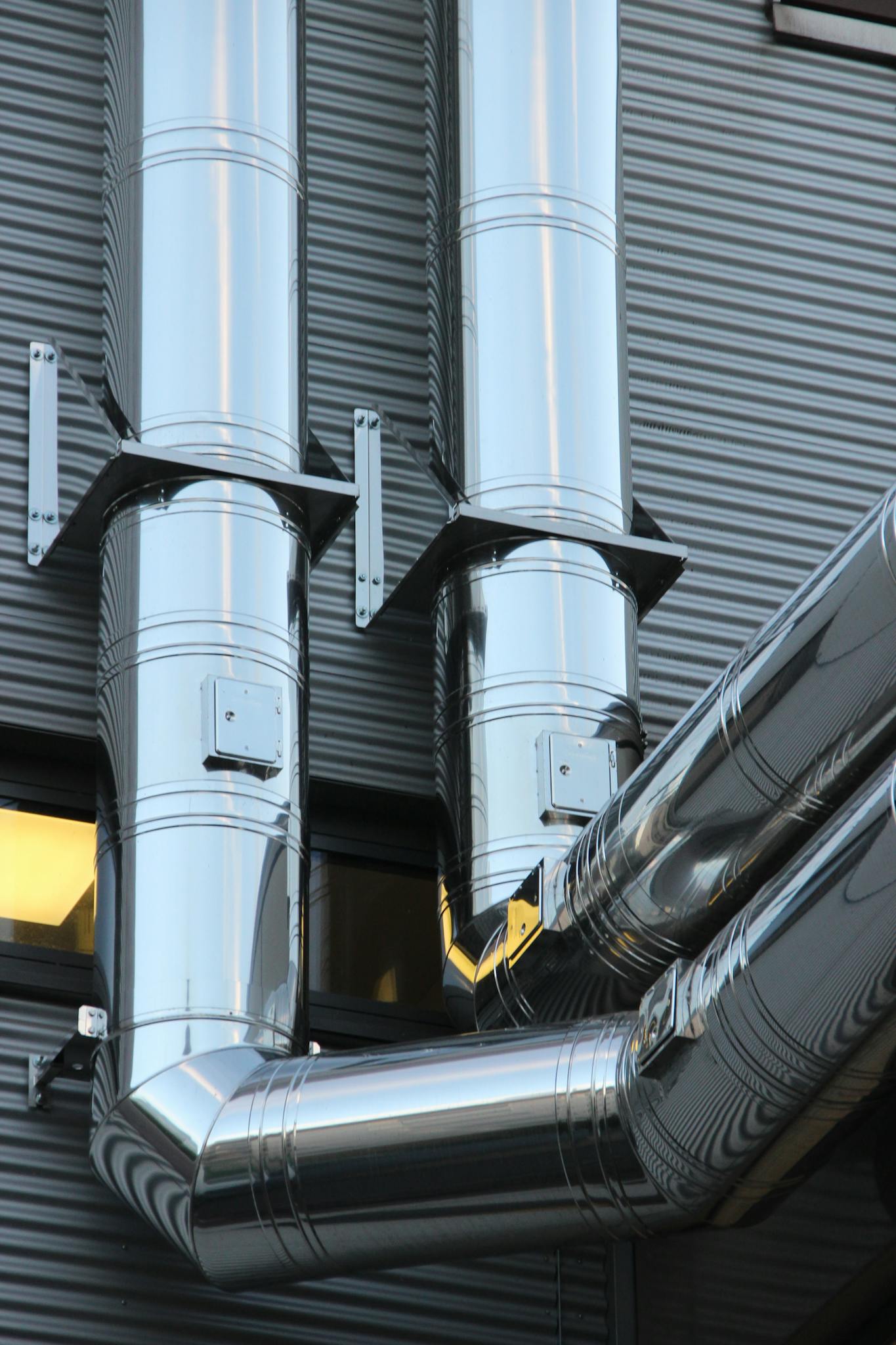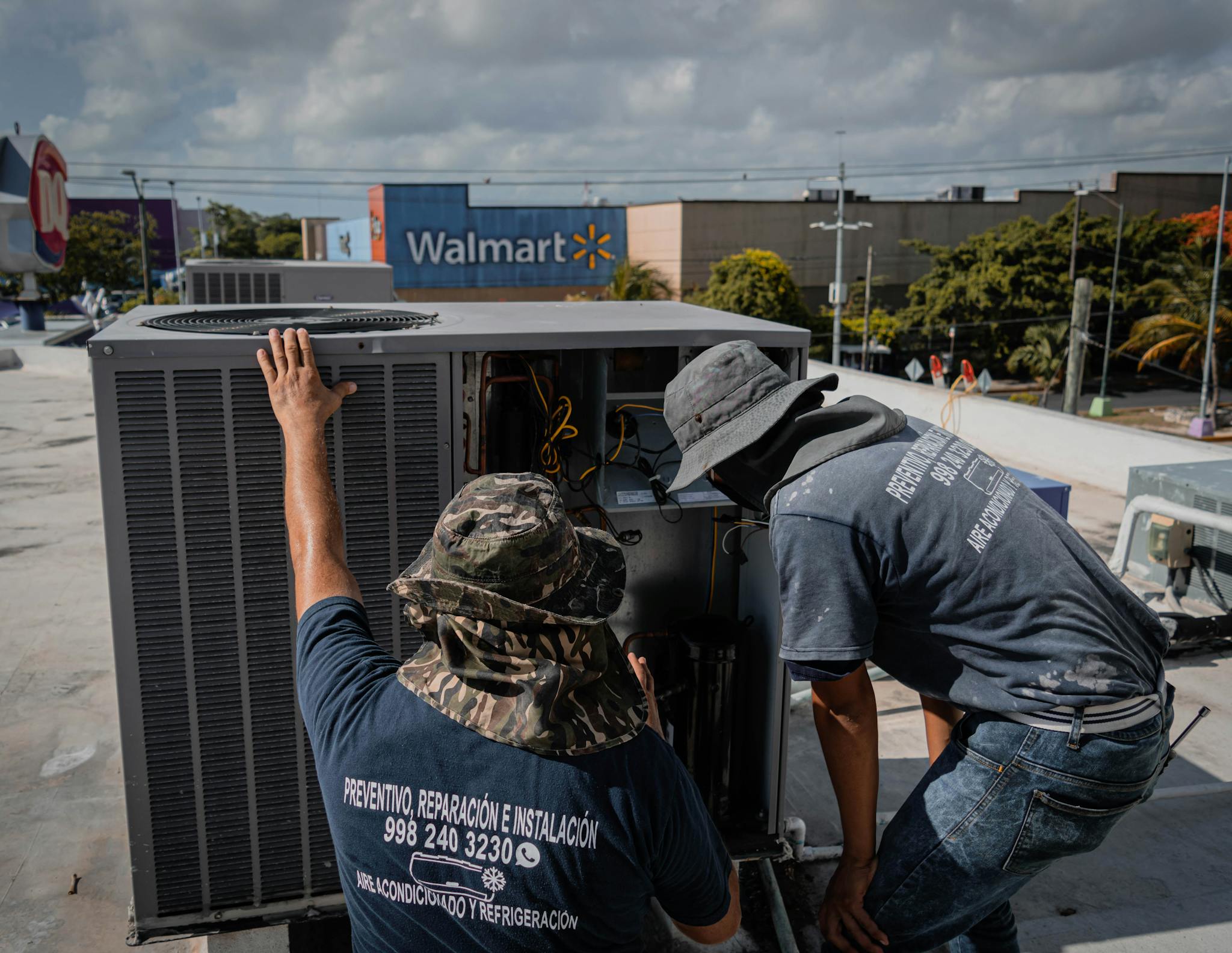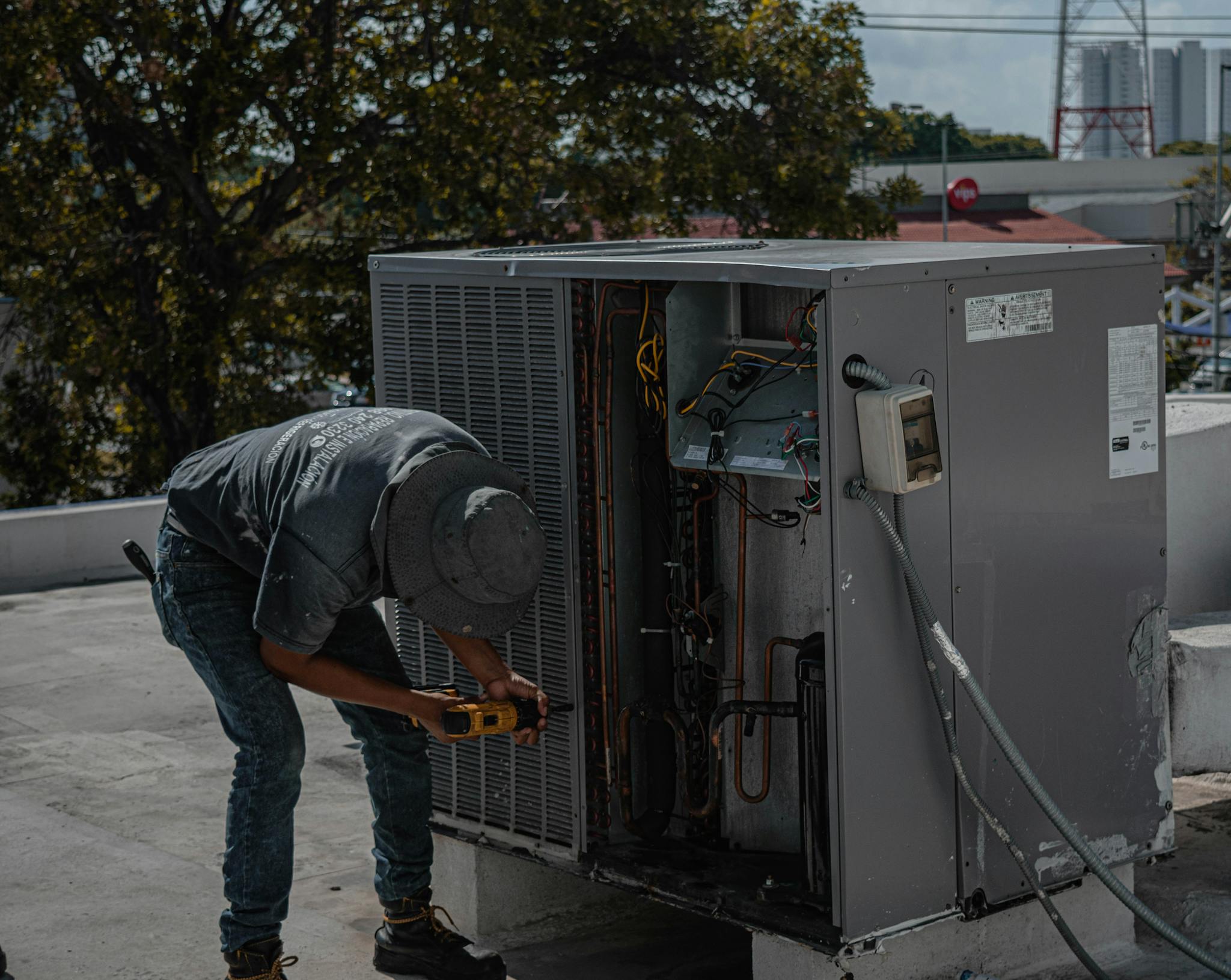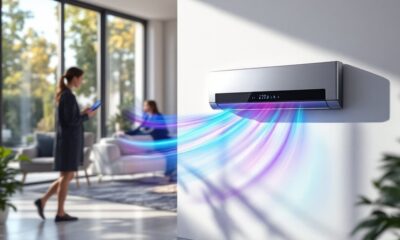Tech
AI Transforms the HVAC Landscape Forever
From predictive maintenance to energy optimization, AI revolutionizes HVAC systems, but the biggest industry changes are yet to come.

Artificial intelligence is revolutionizing the HVAC industry through data-driven optimization and predictive maintenance capabilities. AI systems analyze operational data to enhance system performance, reducing energy consumption by up to 20% while minimizing equipment failures through early detection. Companies like Johnson Controls and Carrier have demonstrated significant improvements, with AI-powered solutions cutting system downtime by 30% and accelerating repairs by 40%. The integration of smart diagnostics, automated scheduling, and energy analytics is transforming traditional HVAC operations into efficient, proactive service models. The continuous evolution of AI technology promises even greater advancements in building management systems and energy optimization.
Understanding AI's HVAC Impact
Three major transformations are reshaping the HVAC industry through artificial intelligence. First, AI-driven analytics are revolutionizing system optimization by processing vast amounts of operational data to achieve peak efficiency.
Second, predictive maintenance capabilities are fundamentally changing how HVAC systems are serviced, shifting from reactive to proactive approaches.
Third, automated administrative processes are streamlining contractor operations, reducing overhead costs considerably.
These transformations are producing measurable results, with studies indicating a potential 40% increase in productivity by 2035. The integration of AI technologies enables HVAC systems to adapt in real-time to usage patterns and weather conditions, while simultaneously analyzing performance metrics to prevent equipment failures. Additionally, AI solutions can handle multiple calls simultaneously, ensuring that customer inquiries are addressed promptly and effectively.
For contractors, this technological evolution means enhanced service delivery and improved customer satisfaction through data-driven decision-making.
Game-Changing Benefits for HVAC
Four game-changing benefits emerge as artificial intelligence revolutionizes the HVAC industry.
First, AI-driven predictive maintenance greatly reduces system failures by identifying potential issues before they escalate into costly breakdowns.
Second, automated optimization of HVAC operations delivers considerable energy savings through real-time adjustments based on usage patterns and environmental conditions.
Third, AI streamlines administrative tasks, allowing contractors to focus on core service delivery while reducing operational overhead. The technology automates everything from appointment scheduling to maintenance documentation.
Finally, AI enhances customer service through data-driven personalization, enabling HVAC providers to anticipate client needs and deliver tailored solutions. These systems analyze historical data to recommend ideal service schedules and system upgrades, resulting in improved customer satisfaction and increased business efficiency.
Success Stories in Practice
Leading HVAC companies across the nation have demonstrated remarkable success through AI implementation. Companies integrating artificial intelligence report significant improvements in operational efficiency, customer satisfaction, and bottom-line results.
These real-world applications showcase AI's transformative impact on the industry.
- Johnson Controls achieved 20% energy reduction by implementing AI-driven predictive maintenance systems across commercial installations.
- ServiceTitan leveraged AI automation to process over 10,000 service requests monthly, reducing response times by 45% while maintaining accuracy.
- Carrier's smart building solutions, powered by AI algorithms, decreased system downtime by 30% through early fault detection and automated scheduling.
These documented successes underscore AI's capacity to revolutionize HVAC operations, providing tangible evidence of its value in modern climate control systems.
Smart Tools for Contractors
Modern HVAC contractors now have access to an extensive array of AI-powered smart tools that streamline their daily operations. These sophisticated systems integrate seamlessly into existing workflows, enabling contractors to automate routine tasks and focus on high-value activities. From predictive maintenance algorithms to automated scheduling systems, these tools transform traditional HVAC practices.
| Tool Category | Primary Function | Business Impact |
|---|---|---|
| Diagnostic AI | System Analysis | 40% Faster Repairs |
| Scheduling Systems | Resource Management | 30% More Appointments |
| Energy Analytics | Usage Optimization | 25% Cost Reduction |
| Customer Portal | Service Integration | 50% Better Retention |
The implementation of these AI solutions greatly reduces administrative overhead while enhancing service quality. Contractors utilizing these technologies report substantial improvements in operational efficiency and customer satisfaction metrics, positioning them for sustainable growth in an increasingly competitive market.
The Road Ahead
The future of HVAC technology stands at a pivotal juncture as artificial intelligence continues to reshape industry standards and capabilities. Industry forecasts suggest a transformation in how systems are designed, maintained, and optimized through AI-driven innovations.
As HVAC professionals adapt to these emerging technologies, the integration of machine learning algorithms and predictive analytics will become standard practice.
- Remote diagnostic capabilities will enable real-time system monitoring and automated fault detection.
- Integration with IoT devices will create seamless, interconnected building management systems.
- Advanced AI algorithms will optimize energy consumption through predictive load balancing.
These developments signal a shift toward more efficient, autonomous HVAC operations.
Contractors who embrace these technological advances now position themselves at the forefront of industry evolution, ready to leverage new opportunities for growth and service excellence.
Frequently Asked Questions
How Much Does Implementing AI Technology Typically Cost for HVAC Contractors?
Implementation costs for HVAC contractors vary considerably, ranging from $5,000-50,000 depending on system complexity, with basic automation tools starting around $5,000 and extensive solutions requiring larger investments.
What Training Requirements Exist for Staff to Effectively Use AI Systems?
Studies show 85% of successful AI implementations require basic digital literacy training, followed by system-specific modules, hands-on practice sessions, and ongoing support for HVAC staff members.
Can AI Systems Integrate With Existing Legacy HVAC Equipment?
Modern AI systems can integrate with legacy HVAC equipment through retrofitted sensors and control interfaces, though compatibility varies by equipment age and existing control systems' capabilities.
What Cybersecurity Risks Come With Implementing AI in HVAC Systems?
Implementing AI in HVAC systems presents risks including unauthorized access to control systems, data breaches, malware attacks, network vulnerabilities, and potential manipulation of building environmental controls through connected devices.
How Long Does It Take to See Return on Investment From AI Implementation?
ROI timeline varies from 6-18 months, depending on implementation scale and specific solutions. Most contractors see initial returns through reduced operational costs and improved service efficiency within the first year.
Conclusion
While artificial intelligence initially sparked concerns about job displacement in HVAC, the technology has ironically become the industry's greatest ally. The transformation from manual operations to AI-driven solutions demonstrates unprecedented efficiency gains, predictive capabilities, and service improvements. As smart systems continue evolving, the synthesis of human expertise and machine intelligence creates a new paradigm where automation enhances rather than replaces the HVAC professional's role, marking an irreversible shift toward technological integration.
Tech
Revolutionizing Cooling: The Rise of 2-PIC
Cutting-edge Two-Phase Immersion Cooling transforms data centers with 90% energy savings, but its true potential extends far beyond efficiency.

Two-Phase Immersion Cooling (2-PIC) represents a transformative solution for data center thermal management, utilizing dielectric fluid submersion to achieve remarkable efficiency gains. This innovative technology reduces cooling energy consumption by up to 90% compared to traditional methods while enabling a 60% smaller physical footprint. By addressing critical environmental challenges, 2-PIC helps combat the data center industry's significant energy usage, which currently accounts for 1% of global carbon emissions. The technology operates at higher temperatures while maintaining peak performance, minimizing both water consumption and operational costs. This breakthrough approach to cooling positions 2-PIC at the forefront of sustainable data center evolution.
Understanding Two-Phase Immersion Cooling
Nearly all traditional data centers rely on air or water cooling systems, but these methods are reaching their limits as computing demands intensify.
Two-phase immersion cooling (2-PIC) offers a revolutionary solution by submerging servers directly in dielectric fluid, which evaporates as it absorbs heat and then condenses back to liquid form.
This innovative approach delivers superior cooling efficiency, reducing energy consumption by up to 90% compared to conventional methods.
The process operates at higher temperatures while maintaining peak performance, enabling greater server density and a 60% smaller physical footprint.
As data centers face mounting pressure to reduce their environmental impact, 2-PIC's ability to minimize both energy usage and water consumption makes it an increasingly attractive option for meeting future cooling challenges. Additionally, the implementation of AI solutions in business operations can further enhance efficiency and responsiveness in tech-driven environments.
The Environmental Impact Challenge
Data centers pose one of today's most pressing environmental challenges, consuming 460 TWh of electricity annually and contributing to 1% of global carbon emissions. Traditional cooling methods, which account for 40% of data center energy consumption, require substantial resources, including an average of 300,000 gallons of water daily per facility.
| Impact Category | Traditional Cooling | 2-PIC Solution |
|---|---|---|
| Energy Use | High (40% of total) | 90% reduction |
| Water Usage | 300k gallons/day | Near-zero |
| Carbon Footprint | Significant | Reduced by 60% |
| Space Required | Large footprint | 60% less space |
The introduction of 2-PIC technology presents a viable solution to these environmental concerns, offering significant reductions in energy consumption, water usage, and physical footprint while maintaining ideal performance levels for increasing computational demands.
Breaking Down Energy Consumption
Understanding energy consumption patterns in cooling systems reveals the transformative potential of 2-PIC technology. Traditional data centers currently allocate approximately 40% of their total electricity usage to cooling processes alone, contributing greatly to their environmental footprint.
This substantial energy demand translates to both high operational costs and considerable carbon emissions.
Two-phase immersion cooling presents a revolutionary solution, achieving up to 90% reduction in cooling energy consumption compared to conventional methods. This dramatic improvement stems from the technology's efficient heat transfer properties and ability to operate at higher temperatures while maintaining ideal performance.
Sustainable Solutions for Data Centers
As environmental concerns mount and regulations tighten, sustainable solutions for data centers have become imperative rather than optional.
Two-phase immersion cooling (2-PIC) emerges as a groundbreaking solution, offering up to 90% reduction in cooling energy consumption compared to traditional methods.
This innovative technology addresses multiple sustainability challenges simultaneously. By utilizing advanced dielectric fluids, 2-PIC systems achieve higher operational temperatures while reducing physical footprint by 60%, enabling increased server density.
The environmental impact is considerable, with the potential to save 340 TWh of energy globally by 2055. Additionally, 2-PIC substantially reduces water consumption, a critical factor given that traditional data centers typically use 300,000 gallons daily for cooling operations.
This advancement aligns with industry goals of achieving net-zero emissions by 2050.
Technology Advantages and Performance
The revolutionary advantages of two-phase immersion cooling extend far beyond basic temperature regulation. This technology demonstrates remarkable efficiency improvements while addressing critical challenges in modern data center operations.
When compared to traditional cooling methods, 2-PIC delivers superior performance through its innovative approach to heat management.
Key advantages of 2-PIC technology include:
- Up to 90% reduction in cooling energy consumption, considerably lowering operational costs
- 60% reduction in physical footprint, enabling higher server density and space optimization
- Enhanced reliability through consistent temperature maintenance across all components
- Lower global warming potential through advanced dielectric fluids and reduced energy requirements
These benefits position 2-PIC as a transformative solution for data centers facing increasing computational demands while working to meet sustainability goals.
Market Growth and Industry Adoption
Market adoption of two-phase immersion cooling has gained significant momentum as data center operators seek more efficient and sustainable cooling solutions.
Industry collaborations and technological advancements have accelerated the implementation of 2-PIC systems across major facilities, driven by the growing demands of AI computing and data processing.
The technology's proven ability to reduce cooling energy consumption by up to 90% while enabling higher server density has attracted significant interest from operators looking to future-proof their infrastructure.
This adoption trend is further supported by the projected growth in data center power consumption, expected to reach 35 gigawatts by 2030 in the U.S. alone.
As environmental regulations tighten and sustainability goals become more pressing, 2-PIC's ability to minimize both energy usage and physical footprint positions it as a cornerstone technology for next-generation data centers.
Future Trends and Opportunities
Looking ahead, emerging trends in two-phase immersion cooling point toward unprecedented opportunities for innovation and growth.
As data centers evolve to meet increasing computational demands, 2-PIC technology is positioned to address critical challenges in sustainability and efficiency.
- Integration of AI-powered monitoring systems to optimize cooling performance and predict maintenance needs
- Development of next-generation dielectric fluids with even lower environmental impact and enhanced thermal properties
- Expansion of 2-PIC applications beyond data centers into edge computing and telecommunications infrastructure
- Standardization of 2-PIC implementations to facilitate widespread adoption and reduce installation complexity
These advancements, coupled with the projected energy savings of 340 TWh by 2055, indicate a transformative shift in cooling technology that will reshape data center operations and environmental sustainability efforts.
Frequently Asked Questions
What Safety Protocols Are Required When Handling Dielectric Fluids in 2-Pic Systems?
Essential safety protocols for dielectric fluid handling include personal protective equipment, proper ventilation, spill containment measures, regular fluid testing, and strict maintenance procedures to prevent contamination and guarantee worker safety.
How Does 2-Pic Technology Impact Hardware Warranties and Insurance Coverage?
Like charting uncharted waters, 2-PIC adoption requires careful consideration of warranty implications. Many manufacturers are updating policies to specifically address immersion cooling, though insurance coverage varies among providers.
What Maintenance Schedule Is Typically Required for 2-Pic Systems?
Regular maintenance for 2-PIC systems includes quarterly fluid quality checks, annual dielectric fluid replacement, monthly filter inspections, and continuous monitoring of temperature, pressure, and fluid levels through integrated sensors.
Can Existing Data Centers Be Retrofitted With 2-Pic Technology?
Existing data centers can be retrofitted with 2-PIC technology, though it requires careful planning for infrastructure modifications, including liquid-tight containment systems and appropriate dielectric fluid handling equipment.
What Specialized Training Do Technicians Need to Operate 2-Pic Cooling Systems?
Like master craftsmen perfecting their trade, 2-PIC technicians require specialized HVAC certification, dielectric fluid handling training, and expertise in monitoring advanced digital control systems and safety protocols.
Conclusion
While traditional cooling methods struggle to keep pace with escalating data center demands, two-phase immersion cooling presents an elegant paradox: the simpler solution proves more revolutionary. As data centers face mounting pressure to reduce their environmental impact, 2-PIC technology emerges as a transformative force, promising dramatic reductions in energy consumption and spatial requirements. The irony lies in how this cutting-edge technology relies on basic principles of thermodynamics to solve modern computing's most complex challenges.
-

 Breaking News1 year ago
Breaking News1 year agoCentury Unveils New Distribution Hub in Houston
-
Business1 year ago
The only Google Business Profile Features That directly Make Your Listing Rank Higher
-

 Blogging1 year ago
Blogging1 year agoEffective Blog Promotion: Strategies to Increase Your Reach
-

 Blogging1 year ago
Blogging1 year agoThe Essentials of Blogging: Tips and Strategies for Success
-

 Training and Education11 months ago
Training and Education11 months agoNavigating New HVAC Regulations: Compliance and Education
-

 Blogging1 year ago
Blogging1 year agoNever Run Out of Ideas: Top Tips for Generating Fresh Blog Topics
-

 Blogging1 year ago
Blogging1 year agoBuilding a Loyal Blog Audience: Strategies for Engagement and Growth
-

 Blogging1 year ago
Blogging1 year agoCrafting the Perfect Blog Structure: A Guide for Effective Blogging






